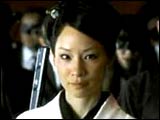She lies there amidst the carnage -- battered, bloodied, broken.
A hand -- holding a pristine white kerchief embossed with the name Bill -- reaches out; gently, the hand brushes the blood off her face while a soft voice croons, of blood and of pain.
As the hand pulls back, you hear, in the background, the metallic click of a gun being cocked -- and BANG!
 The frame jumps from gritty black and white to eye-popping color -- and into a bruising battle between The Bride (Uma Thurman) and Copperhead (Vivicia A Fox).
The frame jumps from gritty black and white to eye-popping color -- and into a bruising battle between The Bride (Uma Thurman) and Copperhead (Vivicia A Fox).
And all that is just the first 10 minutes of Quentin Tarantino's Kill Bill -- or, as the director titles it with unapologetic grandiloquence, Quentin Tarantino's Fourth Film.
Former assassin The Bride aka Black Mamba is widowed at the altar when Bill (David Carradine) leads his four-member Deadly Viper Assassination Squad (DiVAS) in an orgy of massacre that leaves the entire wedding party dead.
The Bride, shot in the head, lapses into a coma from which she awakens, four-and-a-half years later, bent on revenge.
Her targets are Bill and his DiVAS -- O-Ren Ishii aka Cottonmouth (Lucy Liu), Vernita Green aka Copperhead (Fox), Budd aka Side Winder (Michael Madsen), and Elle Driver aka California Mountain Snake (Daryl Hannah).
The Bride first goes after Copperhead; mission accomplished, she flies off to Okinawa to acquire a sword from the legendary Hattori Hanzo (martial arts superstar Sonny Chiba) and then lands up in Tokyo to take on Cottonmouth.
Or at least that is the order in which it unfolds, thanks to Tarantino's penchant for playing with time and space; the actual order of retributive events is somewhat different.
That is Kill Bill Volume 1 -- a revenge tale in two parts, with 'Volume 2' scheduled for release in February.
THE single biggest talking point, outside of the fact that Tarantino is making a movie after six years, is its two-volume structure; it is also the single biggest reason why reviewing this film is a task without precedent.
Do you review what you have just been stunned senseless by, or do you wait for the second part and, hopefully, for answers to the questions this episode leaves unanswered?
In what has proved to be the year of sequels (and, as in the case of The Matrix, sequels of sequels), there is no real reason to jib at a movie in two parts. There is, however, one critical difference between Kill Bill and the dozens of franchises that make repeated bows on screen.
 Any and all of the films that have been serialised, from the likes of James Bond, Mad Max and Rocky to the contemporary Lord of the Rings, The Matrix and even the campy Charlie's Angels, each film has been a standalone entity; each has a story with a beginning, middle and, crucially, an end.
Any and all of the films that have been serialised, from the likes of James Bond, Mad Max and Rocky to the contemporary Lord of the Rings, The Matrix and even the campy Charlie's Angels, each film has been a standalone entity; each has a story with a beginning, middle and, crucially, an end.
Not Tarantino's latest, though. In Volume 1, there is plenty of killing, but almost no Bill; he, along with Side Winder and California Mountain Snake, have been left for Volume 2. The result is that once you get out of the theatre and into the open air, and shake off the impact of the visceral twenty-minute action sequence that climaxes the 105 minute film, you have this strange feeling of incompleteness, almost as if you left the theatre at the interval.
The question, pre-release, was -- would the trick work? Would the director be able to sink the hook down deep into the audience?
He does, with one out-of-left-field sign-off line that baits the hook.
Tarantino was once asked whether he went to film school. The one-time video clerk's reply was a self-defining classic: 'No. I went to films.'
Here, the films have come to Tarantino. Kill Bill is a pastiche of film forms -- Western shoot-'em-ups, Shaw Brothers kung fu classics (I thought I saw a nod to one of my favourites, Master of the Flying Guillotine; others, more steeped in martial arts lore, will probably spot more), and anime; Tarantino brings the disparate forms together in a structure that is part glorious gothic architecture, part exuberantly childish Meccano-set construction.
The wedding massacre forms the film's bravura opening black and white sequence that sets it all up; from then on, Team Tarantino is at its best with brilliant camera work, a stunning background score, and unpredictable shifts in mood, time and place that propel the story forward, backward, and every which way the director wants it to go, sometimes all at once.
Tarantino structures the film like a book, with chapters; unlike your typical book's narrative style, each 'chapter' of the film is in a different style. Once he brings the viewer up to speed on the back story, Tarantino jumps the action frenetically, from California to Okinawa to a Tokyo nightclub that is the scene for the climactic (at least, climactic for part one) battle.
The kinetic fight sequence that ends Volume 1 could well become a cult classic. The early part of the battle scene is set against the backdrop of raucous rock; the hush of a rapidly emptying nightclub then erupts in the clash of steel as Thurman tangles first with the precocious mace-wielding bodyguard, then with the 88-member yakuza bodyguard that surrounds O-Ren Ishiii.
In another abrupt mood shift from the energetic to the lyrical, Tarantino sets the concluding clash between Ishii and The Bride against the backdrop of a picture perfect Japanese garden and gently falling snow; the use of a bamboo fountain to frame the martial tension is one among many gee-whiz moments the film is studded with.
 It is a grandstand performance by a chronic risk-taker; to Tarantino's credit, he pulls it off with élan.
It is a grandstand performance by a chronic risk-taker; to Tarantino's credit, he pulls it off with élan.
Gore is a potential downer, too much of it could prove an audience turn-off. Tarantino solves the problem by laying it on thick. Scenes of a severed head flying while the neck it was attached to spouts blood like an ersatz fountain have an over-the-top, campy quality that is more comical than nauseating; in fact, an audience of about 50 at the first show of the film, at Loew's on 19th and Broadway in New York, laughed at and applauded one such scene.
PERFORMANCE-WISE, Uma Thurman is the statuesque raison d'etre for the film. The role is written for her (pre-release publicity spoke of how the idea for the film originated 10 years ago, when Thurman tossed off the concept of a female assassin on a revenge mission, and Tarantino picked up the ball and ran with it). Thurman plays it straight, cold, and emotionless.
Perhaps because she, as protagonist, comes across as a nerveless killing machine, you don't root for her quite as much as you would, say, for a Rocky Balboa battered by a Mr T.
Another reason for the lack of real empathy could be that you never get to see the arch villain -- Bill, in the film, is just a voice in the opening sequence, a fleeting presence in another scene, and, again, a voice and a hand right at the end. He is more suggested than real. But then, it really doesn't matter -- Tarantino is appealing here not to your emotions but to your senses.
Vivicia A Fox has comparatively little screen time; yet, one of the magic moments of the film punctuates the knife fight between her and Thurman (to say anything more would spoil the moment).
Sonny Chiba as the swordmaker is solidly impressive; given his legendary status in the world of martial arts films, I found myself wishing that he had, at least fleetingly, showcased his skills.
Lucy Liu as Cottonmouth is good. Liu, so wooden in Charlie's Angels 2, is here full of fire. But the unexpectedly brilliant turns come from Chiaki Kuriyama as Cottonmouth's teenage mace-wielding bodyguard (the showdown between her and Thurman is alone worth the price of admission) and from Julie Dreyfus as Liu's assistant.
Robert Richardson's lighting and cinematography, from the opening black and white sequence to the stunningly lit colour
portions that follow, is Oscar-bait. Sally Menke, Tarantino's long-time editor, is hugely competent in the way she moves the film right along; she is, with it, occasionally tolerant of the director's self-indulgence.
The rest of the A-list crew is equally on top form -- Kumiko Ogawa and Catherine Marie Thomas with the costumes (when you see the posters, you wonder a bit about Thurman's sunflower yellow track-suit; up there on screen, you realise why no other colour would have done); Yohei Tanada and David Wasco's eye-popping sets; and Production IG's addictive anime sequence.
Films of this type are only as good as the fight sequences. Yuen Wo-Ping outdoes his Matrix effort and leaves Crouching Tiger Hidden Dragon behind with sequences that make you wish movies came with a built-in rewind-and-replay feature.
Tarantino has in the past proved himself an adept at choosing the music to go with his cinematic moods; this film is no different. The film begins rolling to a slowed-down version of Nancy Sinatra's hit 'Bang Bang -- My Baby Shot Me Down' and, from that point on, the soundtrack is derived entirely from the 1960s and 1970s. My personal favourites outside of the movie opener -- for the music, and the way it is used -- are the rendition of pan flute maestro Zamfir's 'Lonely Shepherd' and the Latino-style rendering of the Santa Esmeralda hit 'Don't Let Me Be Misunderstood'.
In his earlier films -- notably Pulp Fiction -- Tarantino had shown an enviable mastery of dialogue; you went back to see his films to make sure you hadn't missed any of the throwaway lines. In Kill Bill, there is an almost studied absence of that Tarantino trademark. This one is an action flick, through and through, and laugh-out-loud moments are rare.
But Tarantino makes up for it here with the action, the odd in-joke (check out the 'Klingon proverb' right at the start), and superb pacing; his tension-release-tension pulse is impeccable.
This film is finally about Tarantino himself, and about his monumental self-belief. From the decision to split a story down the middle, to end Volume 1 at the second plot point, and to hold back the second half, to the use of a chapter-style storytelling, to his trademark warping of time, the director takes more risks than you would expect of someone who has such an awesome reputation to protect.
In many ways, the director is to cinema what Hillary Clinton is to US politics -- a deeply divisive presence you either love, or loathe, but can never be indifferent to. To borrow a phrase used to describe novelist P G Wodehouse, Quentin Tarantino is contemporary cinema's performing flea -- and you have to keep in mind that not everyone likes fleas.






 © 2025
© 2025